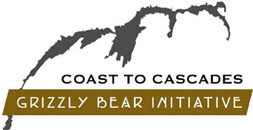Few animals are as synonymous with the wilderness of British Columbia as grizzly bears (also known as brown bears, or Ursus arctos on formal occasions). These large, majestic animals roam the wild places of our province and are great indicators of the overall health of an ecosystem. Generally speaking, in order to support keystone species like grizzly bears, every element of an area needs to be in tip-top shape. When thinking about grizzly bears as canaries in the coalmine, two key variables to consider are their diet and physical size.
In terms of their scientific classification, grizzly bears fall into the order Carnivora with lions, wolves, and the other toothy beast that make up the list of fairy tale bad guys. There are seven families of land carnivores, and bears are the largest in size. Calling grizzlies carnivores is a bit of a misnomer, however – only about 15 percent of their diet is composed of meat. In fact, during the spring and summer, these allegedy fierce predators are pretty much vegetarians, feasting on roots, and berries, with their fall diet expanding to include nuts and fish (especially salmon).
The most obvious fact about grizzly bears is that they are massive. It is the second largest bear in size, after the polar bear (Ursos maritimus) and by far the largest species you are likely to have crash a picnic. Grizzlies often weigh between 170 and 260 kilograms (375 to 570 lbs), although many have been recorded up to and above 500 kilograms (1100 lbs). The subspecies of grizzlies that like on Kodiak Island in Alaska can even tip the scales at 680 kg (1500 lbs) at peak times. The nose-to-tail length of an adult grizzly bear averages to 1.8 meters (6 feet), but they can grow to reach 2.7 meters (nearly 9 feet). Grizzly paws are also larger than those of their black bear cousins and can be as big as 36 cm by 20 cm (14 inches by 8 inches), with claws up to 10 cm (4 inches) long.
Size in grizzly bears is a product of diet, which in turn is dependent on the quality of the habitat they live in. If grizzly bears are doing well in an area, it is because of the resources available to them. Having diversity in food sources helps a grizzly bear reach its full potential (other animals benefit from those diverse food resources too).
Historically, grizzlies had the largest range of any bear known to science. There was once a time when a person could walk from Mexico to Alaska and from the Pacific Coast to the Mississippi River, dodging grizzlies the entire way. Although only a fraction of that range remains, grizzlies have come to embody the ideal of pristine, untamed wilderness wherever they are found. It is important to recognize and understand the connection between these animals and their environment so we can best preserve the areas where grizzlies roam, both for their benefit and our own.
--
Special thanks to Steve Kux for editing and contributing.

